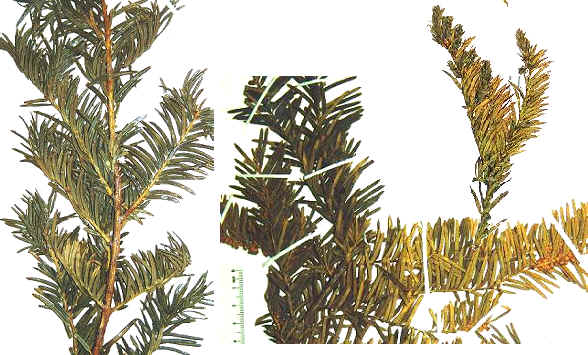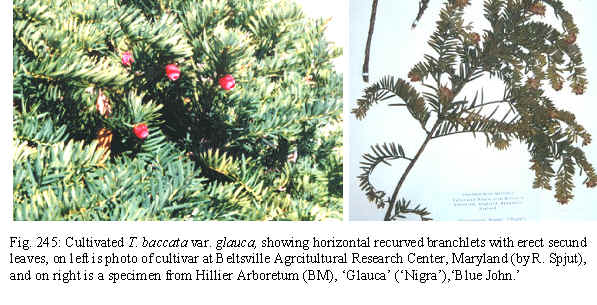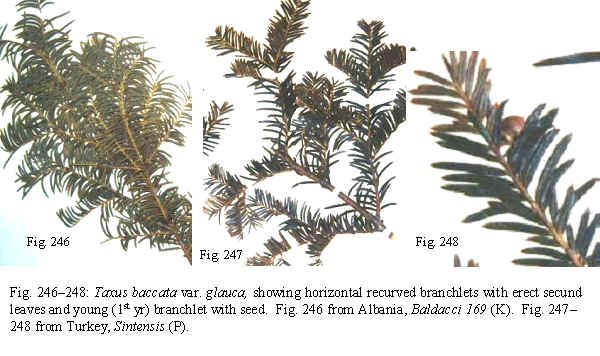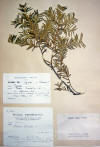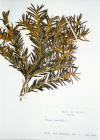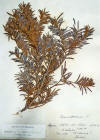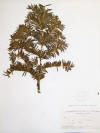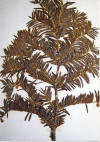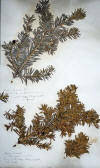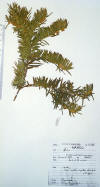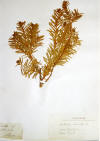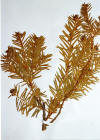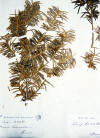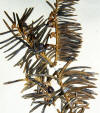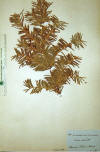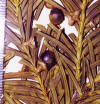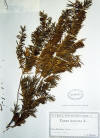1e. Taxus baccata var. glauca Carrière, Traité gén. conif. 519 (1855); T. baccata (f.) glauca (Carrière) Beissner, Handb. Nandelholzk. 175 (1891). Original material in horticulture, type unknown.—Neotype (designated by Spjut 2007b)—Horticulture: Armenia. Tschunakuchi, horticulture—ex Herb. Petropolitani, Szovich 610 at S! (C-2072, with seed, leaves with abaxial bare marginal zone 4 cells wide followed by 10 stomata rows/band, papillose midrib); isoneotype at P! (with seed, 9 stomata rows/band, abaxial margin—4 smooth cells, papillose midrib). Other related material: Hort. Ex Hillier Arboretum, England, 22 Mar. 1976, “BM(NH) 1247,” in adnot. T. baccata ‘Glauca’ (“Nigra”), “Blue John” (BM!). Taxus baccata (var.) horizontalis (Pepin) Carrière, Traité gén. Conif. 518 (1855), taxonomic synonym proposed. T. horizontalis Pépin, Rev. Hort. 84 (1850, n.v.). T. baccata f. horizontalis (Carrière) Beissner, Handb. Nandelholzk. 172 (1891). Developed at Bertin Nursery in Versailles, France before 1850 (den Ouden & Boom 1965; Krüssmann 1985). Original herbarium material and native origin unknown. Type undetermined. Taxus baccata nidpathensis Paul, J. Hort. Soc. Lond. 1861: 493 (1861), taxonomic synonym proposed. Type: Scotland: from Nidpath Castle, Tweeddale, specimens or original material undetermined. Glauca yew. Distribution: Euro-Mediterranean. Trees or shrubs with pinnately arranged branchlets on a horizontal branch, the branchlets also horizontal, spreading and often recurved towards apex, or sometimes long pendulous as in var. dovastoniana, yellowish orange, somewhat glaucous in part; persistent bud-scales closely adnate, turgid, ovate, keeled along midnerve, obtuse, yellowish to reddish brown; dried leaves olive green or yellowish on upper surface, the abaxial surface glaucous green or orange to yellowish (when dried), spreading recurved along two sides of branchlets in the same plane, overlapping, often secund near apex of young branchlets and entirely on older branchlets, linear, falcate, slightly concave along abaxial surface, thick and rounded along margins; male cones in globular aggregates, or reflexed and racemose on underside of recurved branchlets; seed maturing on branchlets of the current season, scattered, globose, reddish brown.
Variety glauca is distinguished from other varieties of T. baccata by the leaves overlapping parallel to each other while pointing upwards (erect secund)—especially near apex of branchlets, by their yellowish color in dried herbarium specimens, and by tapering abruptly to an obtuse apex. The branchlets are often yellowish orange (from old dried leaves) and recurved, in contrast to the longer and flexuous (pendulous) branchlets of var. jacksonii. Also, leaves of the Jackson yew retain more of a natural green color, while showing further differences in their more strongly convex curvature across the adaxial surface and by tapering to an acute apex. The horizontal to recurved branchlets of the glauca yew are similarly found in T. recurvata, which is best recognized by the sharp contrast in color between the upper and lower leaf surfaces. The Dovaston yew, however, is most similar to the glauca yew—as seen in the leaf color and pendulous branchlets; it is distinguished by the leaves being darker in color on the adaxial (upper) surface)—in which it helps to have comparative herbarium specimens to see the minor difference in color—and by the leaves spreading upwards and towards the apex of a branchlet along the uppermost part of the branchlet. Occasional specimens of T. baccata var. glauca are not easily distinguished from T. cuspidata relatives. Those with leaves deficient in papillae near the abaxial margins in relatively narrow zones—across 4–6 cells—are easily referred to T. baccata var. glauca, while others with broader marginal zones, such as one from Scandinavia (Bjornstrorn, US)—that appears smooth across 10 marginal cells, are difficult to distinguish not only from T. cuspidata, but also from T. baccata var. jacksonii and T. caespitosa var. latifolia. This distinction becomes even more difficult when rare specimens from E Asia appear similar in their anatomical features to T. baccata var. glauca, as in one specimen of var. latifolia from Manchuria that had a relatively narrow marginal zone of 6 cells without papillae (Maximowicz, P). While I recognize other taxa of yew to have disjunct occurrences—such as T. canadensis in Europe and E North America—the disjunct features in the examples just cited above cannot be assigned with confidence beyond the more or less continuous ranges of T. baccata and T. caespitosa. Therefore, these specimens are referred to their respective taxonomic alliances as also discussed under T. cuspidata—based on phytogeographic data for number of stomata and epapillose marginal cells. The development of papillae on leaves of var. glauca also appear geographically correlated. Plants in the western Europe have more papillae on their leaves, usually within 8 rows of marginal cells as generally found in most European yews, while papillae are often lacking entirely across the midrib, a feature that is often variable among yews of Europe. This is contrast to specimens from Syria and Albania that not only lack papillae on the leaf abaxial midrib, but also across as many as 18 marginal cells. The less papillose leaves of eastern European plants may be hybrids with T. canadensis, or they may have been derived from an older Eurasian T. cuspidata Alliance (clade). In horticulture, var. glauca includes three distinct cultivars. (1) The cv. 'Glauca' or 'Nigra' or 'Blue John', based on a specimen from the Hillier's Arboretum (BM), has long recurved branchlets with oblong glaucous (caesious) leaves, lacking the yellowish color (Fig. 245). (2) A second one, f. horizontalis (Carrière), allegedly a cultivar that originated in France, is known for its long horizontal branches (Knight 1850; Callen 1977), while it may also be distinguished by its golden color (f. semperaurea Dallimore; Rehder 1940, 1949), although a specimen I saw annotated with this name is considered in this treatment to be T. recurvata var. recurvata. I have seen similar plants in cultivation at the Beltsville Agricultural Research Center (Fig. 245). (3) A third—that is typical—has pendulous branchlets, which includes a specimen from horticulture under the name f. pendula as recognized by C. Baenitz (Fig. 114). While the typical form may suggest the Dovaston yew, it is referred to var. glauca by the yellowish color on dried leaves.
Pilger (1916) acknowledged Knight (1850) as an earlier authority for the name—horizontalis—rather than glauca based on Carrière (1855). However, Knight’s (1850) descriptive information on T. baccata var. horizontalis, plants producing “large horizontal branches,” was in context of comparing landscape effects of conifers rather providing taxonomic descriptions; his table of species and varietal names—including this variety—are not differentiated—except for symbols that classify the taxa as either a tree or a shrub. Representative Specimens—Algeria: Atlas de Blida, Univ. Algeria, Apr 1912 (NA); Atlas des Demia, Gamble (K). Morroco: Middle Atlas, Azrou, 5700 ft, Lynes (BM); Ifrane 1400 m, Trethewy 85 (K); Ifrane, 1600 m, Lewalle 12378 (BM). Ireland: Pollawaddy, May 1961, Carruters (K). England: Norfolk, Elsing, monoecious, Vulpy (K). Sweden: Göteborg, Sep. 1900, Thedenius (PH, US); Podermanlane, Bjornstrorn, ex Mus. Stockholm (US). Finland: Aland, par. Lemland, in insula Jungfruskár, Vidlund, Finlandee Exsic. 419 (K, p.p., bottom specimen). Switzerland (Helvetica), Interlaken, in Walde bei Unterseen, 550 m, 30 May 1904, C. Baenitz s.n., annotated T. baccata f. pendula (US: 1395580). Austria: Keck (US). Italy: Cultivated, Tuscany, Villa Rice to San Mercallo, shrub or tree to 30 ft, McDonald: I-37 (US). Albania: Baldacci 169 (K). Turkey: Paphalogonia: Wilajet Kastanbuli, 1892, Sintensis 5118 (K, P). Syria: 1000 m, Nov. 1935, Delbés (P). Armenia: locality in Russian, 22 Mar 1946, Inst. Bot. Acad. Sci. Armenia (US); Tschunakuchi, ex Herb. Petropolitani, Szovich 610 (P).
|
||||
